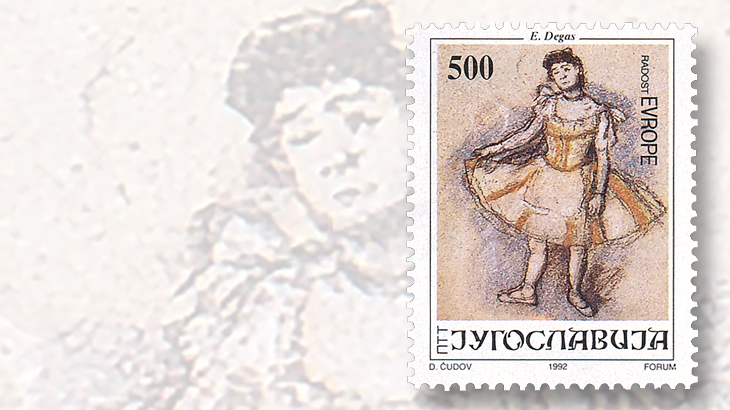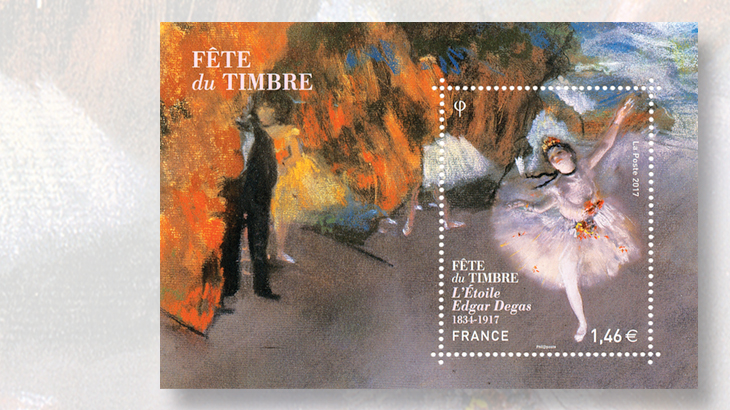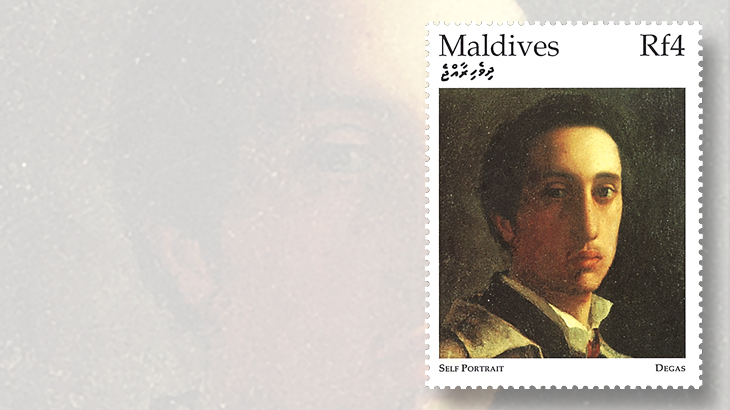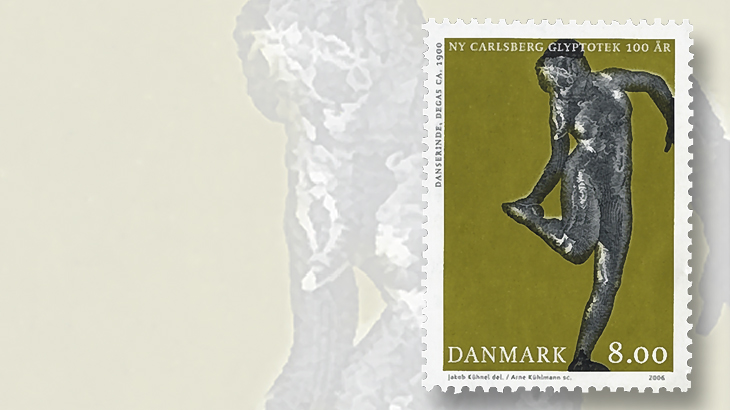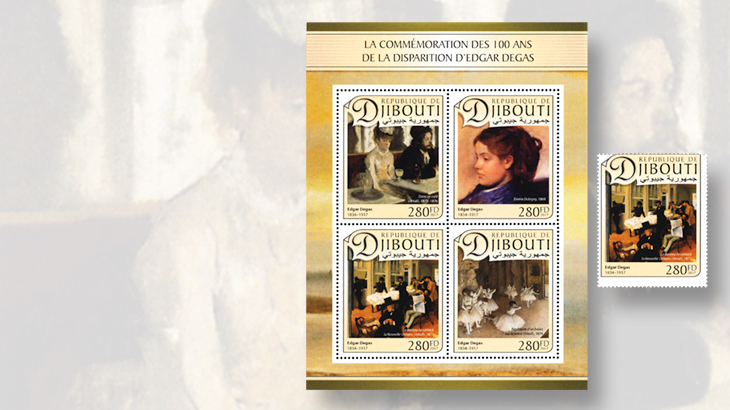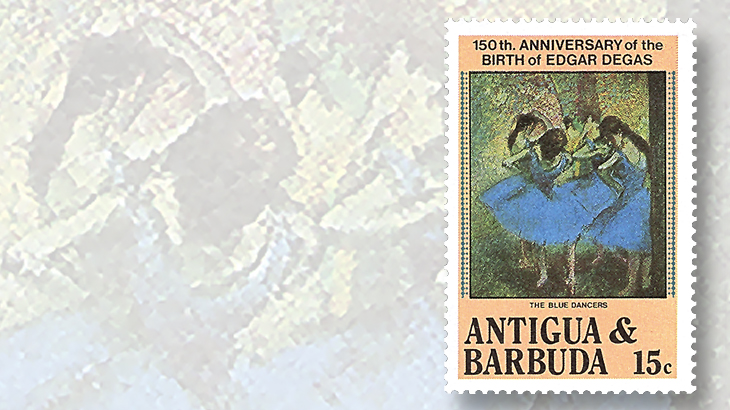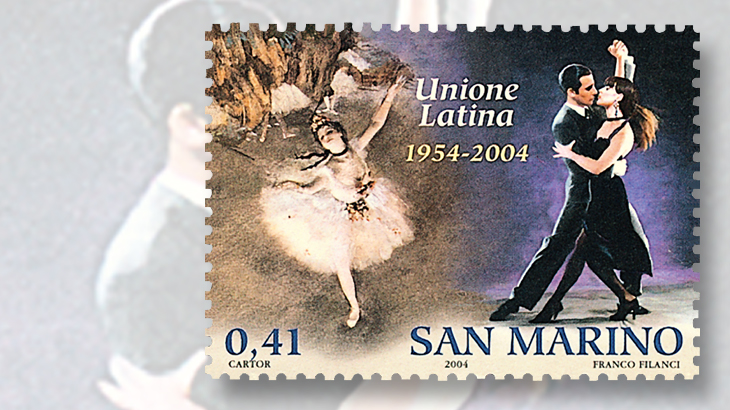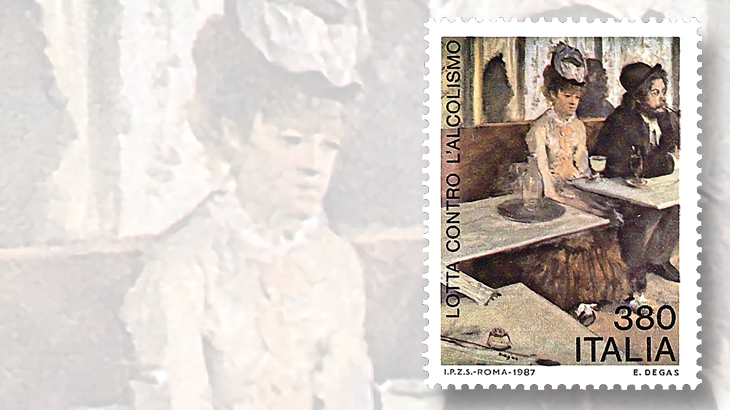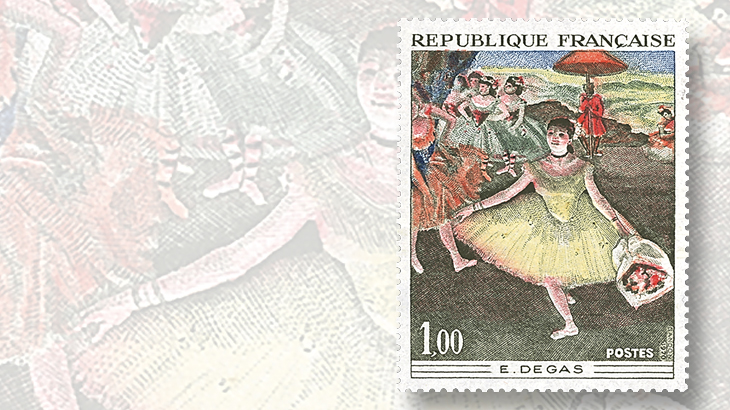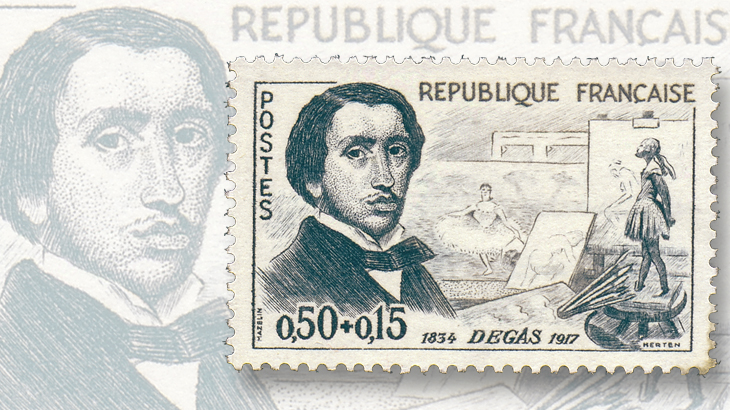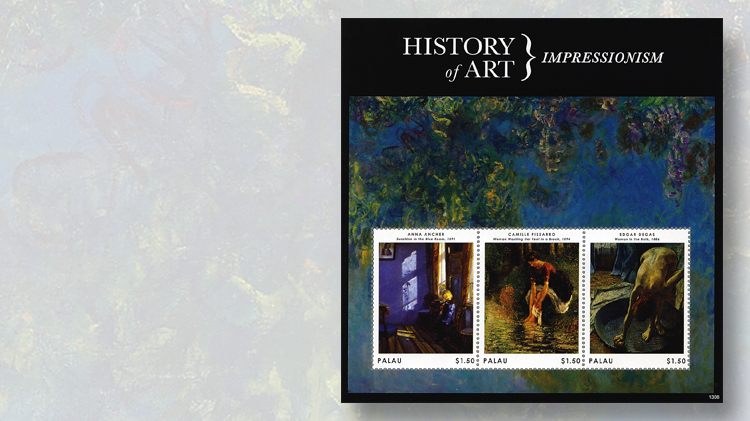World Stamps
Miniature masterpieces: Degas’ art on stamps
Topics on Stamps — By Denise McCarty
From ballerinas, to bathers, to the racetrack, French artist Edgar Degas captured the world around him in his paintings, sculptures and drawings.
Many of these works of art are reproduced on stamps, including several from his native France. The most recent of these was a souvenir sheet issued March of this year for France’s annual stamp festival, Fete du Timbre, held March 11-12.
In keeping with the dance theme introduced in 2014 for Fete du Timbre stamps and souvenir sheets, the sheet pictures one of his most well-known ballet paintings The Star, or L’Etoile in French.
Probably not by coincidence, the souvenir sheet also was issued during the centennial year of Degas’ death, although that is not specically mentioned on the sheet. However, the £1.46 stamp does include an inscription of the years of Degas’ birth and death (1834-1917) below his name.
Connect with Linn’s Stamp News:
Sign up for our newsletter
Like us on Facebook
Follow us on Twitter
Born Hilaire-Germain-Edgar De Gas July 19, 1834, in Paris, Degas died Sept. 27, 1917.
Degas began painting and studying drawing at a young age, but also studied law for a short time. He began exhibiting his work in 1865, but didn’t come to prominence until almost a decade later when he and 29 other artists of the Anonymous Society of Painters, Sculptors, Engravers, etc., organized an exhibition. Held April 15 to May 15, 1874, in Paris, this was considered the first of eight exhibitions of the Impressionists.
Despite participating in seven of these exhibitions, Degas didn’t considered himself an Impressionist.
On the Metropolitan Museum of Art’s Heilbrunn Timeline of Art History, Ruth Schenkel of the department of European paintings wrote: “Degas seems never to have reconciled himself to the label of ‘Impressionist,’ preferring to call himself a ‘Realist’ or ‘Independent.’ Nevertheless, he was one of the group’s founders, an organizer of its exhibitions, and one of its most important core members. Like the Impressionists, he sought to capture fleeting moments in the flow of modern life, yet he showed little interest in painting plein air landscapes [outdoor landscapes], favoring scenes in theaters and cafes illuminated by artificial light, which he used to clarify the contours of his figures, adhering to his Academic training.”
Now part of the collection of the Musee d’Orsay in Paris, The Star was exhibited at the third Impressionist exhibition in 1877.
Gerhard Gruitrooy in the coffee-table book Degas Impressions of a Great Master described this pastel on monotype painting: “With a look of rapture on her face, the ballerina completes her performance, taking a sweeping bow … The dancer is momentarily alone on the stage, receiving the full attention of both the audience and the viewer.”
France
More than a half dozen other face-different stamps from France picture works by Degas. The earliest of these was a semipostal issued June 11, 1960, part of a Red Cross set honoring famous men. The Degas stamp is the high denomination of the set, 50 centimes+15c (Scott B346).
The bicolored (slate black and gray) semipostal was designed by Charles Mazelin and engraved by Claude Hertenberger. A young Degas, probably from his 1855 self-portrait, is shown on the left side of the stamp.
The stamp design also includes four works of art, two that appear to be from Degas’ series featuring women bathing. The other two are immediately recognizable: Ballerina with a Bouquet of Flowers, the 1877 pastel and gouache painting of ballerina Rosita Mauri taking a curtin call; and the sculpture Little Dancer Aged Fourteen.
This sculpture of Marie van Goethem, a young ballerina at the Paris Opera, was the only one that Degas exhibited during his lifetime.
The National Gallery of Art, said: “Now adored, this original wax version of Edgar Degas’ Little Dancer Aged Fourteen was reviled by most critics when it was shown at the 1881 impressionist exhibition in Paris. Art critic Elie de Mont was flabbergasted: ‘I don’t ask that art should always be elegant, but I don’t believe that its role is to champion the cause of ugliness.’ The diminutive figure, the only sculpture Degas exhibited publicly, was described variously as ‘repulsive,’ ‘vicious,’ and ‘a threat to society.’ Modeled in colored wax and adorned with real hair and a fabric costume, Little Dancer decisively broke with 19th-century academic practice by introducing unusual mixed materials and frankly representing a provocative modern subject; Degas added to the controversy by exhibiting it like an anthropological specimen in a glass vitrine.”
As part of an Art series, France pictured Ballerina with a Bouquet of Flowers again, this time in full color, on a 1-franc stamp issued Nov. 14, 1970 (Scott 1276).
It would be more than 35 years before France issued its next Degas stamp in early 2006, one of 10 self-adhesives in a booklet called “Les impressionnistes.” Like all of the stamps in this booklet, the Degas stamp (Scott 3183) is nondenominated with the inscription “lettre 20g” (paying the domestic rate for letters weighing up to 20 grams) in place of the face value.
The stamp shows the 1884-85 pastel known both as Dancers at Rest and simply Dancers, as is inscribed on the stamp. In June 2016, this design was used again (along with the other nine designs from the booklet) on a pane of stamps with attached labels that could be personalized (3175 for the pane, 3175b for the Degas stamp).
Three other French stamp booklets also feature Degas along with other artists. The first of these, issued in 2012, depicts 12 different portraits of women. The Degas stamp (4176) shows his Portrait of a Young Woman, painted in 1867.
In conjunction with its stamp for the Year of the Snake in 2013, France issued a booklet of stamps showing the 12 animals of the Chinese zodiac as represented by different works of art. The last stamp in the booklet pictures a bronze sculpture of a horse by Degas.
Degas displayed an interest in horses and horse racing early in his artistic career. His bronze of a horse marching with one leg raised, Cheval marchant au pas releve, is believed to date from around 1870.
After Degas’ death, approximately 150 sculptures were discovered in his studio. His heirs decided to have 72 of these cast in bronze, each in a limited edition of 22. Twenty of each, marked with the letters A through T, were for the public; one was for the heirs; and the other was for the foundry that cast the bronzes, A.A. Hebrard.
France returned to the theme of portraits for a stamp booklet issued in April 2016 in conjunction with the Normandy Impressionist Festival held April 16 through Sept. 26. The Degas stamp (Scott 5013) shows his portrait of fellow painter Leon Bonnat (1833-1922). The two met when a young Degas was traveling and studying art in Italy (1856-59).
The postal administrations of France and Hong Kong participated in a joint issue in 2012 with the theme of heritage in art, featuring modern sculptures and older paintings by Chinese and French artists. The Racecourse — Amateur Jockeys Close to a Carriage by Degas is reproduced on $3 stamps from Hong Kong (Scott 1492 and one of four stamps in a souvenir sheet, 1493a) and on 89¢ stamps from France (4203 with moisture-activated gum and 4205, a self-adhesive).
In announcing its part of the joint issue, Hong Kong Post said: “This painting illustrates a moment before the race begins. The differing planes on which the various protagonists are situated separate each of their roles in the picture. Each person is depicted from a different angle, and a large part of the canvas remains empty, almost as if it were a moment of real life. This painting is kept in the Musee d’Orsay in Paris.”
This oil on canvas took more than 10 years to finish, 1876-87. According to Gruitrooy, writing in Degas Impressions of a Great Master, it was commissioned by French opera singer, composer and art collector Jean-Baptiste Faure, and only his “threat to seek legal recource convinced Degas to surrender the work in 1887 after having reworked it extensively.”
Other Countries
A good place to start when forming a topical collection is with a checklist, and fortunately the American Topical Association had a checklist of stamps that show Degas’ artwork. The ATA’s checklist service is available to its members. For membership and other information, visit the website.
From this checklist, I discovered that in addition to France and Hong Kong more than 40 other postal admistrations had issued Degas stamps. The list of postal administrations wasn’t quite A to Z, but it was A to Y, Ajam to Yugoslavia.
Since the Ajam stamps aren’t listed in the Scott Standard Postage Stamp Catalogue, I am starting with the next “A” postal administration, Antigua and Barbuda.
In 1984, Antigua and Barbuda was among the countries that issued stamps celebrating the 150th anniversary of Degas’ birth. Paintings of dancers were featured on this set of four stamps and a souvenir sheet, including The Blue Dancers on the 15¢ denomination (Scott 782). Similar late 19th-century paintings with the same title are in Musee d’Orsay and the Pushkin Museum in Moscow. The former is an oil on canvas, and the latter is a pastel.
In addition to this 1984 set, Antigua and Barbuda just issued two souvenir sheets on July 1 to mark the 100th anniversary of Degas’ death. One souvenir sheet contains four se-tenant (side-by-side) stamps featuring portraits, and the other has three se-tenant stamps showing paintings of dancers. The inscription on the latter sheet reads in part, “Degas took special interest in ballet and the human form. More than half of his works depict dancers.”
Two stamps from Yugoslavia picture his paintings of dancers. The first was issued in 1984 (Scott 1709), part of a set honoring various artists. The second one was issued Oct. 2, 1992 (Scott 2181) in an annual series promoting the Joy of Europe festival, an international children’s festival of art, dance and music held in October in Belgrade.
The Maldive Islands has been one of the most prolific issuers of Degas stamps. From 1971 through 2016, it has released more than 20 Degas stamps: Scott 363, 371, 374 in 1971; 371 and 374 were overprinted “ROYAL VISIT 1972” and are listed as 376, 379; 1064-1068 in 1984; 2134a, 2134f, 2134h, 2135b in 1996; and 3123a-d, 3133 in 2014. The stamps of 2016 have not yet been listed in the catalog.
One of the stamps issued in 1996 (Scott 2134a) shows a self-portrait from the collection of the Metropolitan Museum of Art in New York City. The Met’s website, said: “At the start of his career, Degas produced some forty self-portraits in various media. This likeness dates to about 1855–56, when the young artist quit his formal training at the Ecole des Beaux-Arts and set off for an extended sojourn in Italy. It reflects Degas’s awareness of the self-portraiture of Rembrandt, Ingres, and Delacroix.”
In general, Degas stamps fall into one of three categories: They honor the artist; they depict famous works by various artists; or they commemorate something entirely different, and the painting represents that subject.
New stamps remembering Degas on the 100th anniversary of his death, such as the Jan. 31 set from Djibouti, fall into the first category. This issue contains five stamps: a 960-franc stamp showing The Dance Class in a souvenir sheet; and four se-tenant 280fr stamps in another souvenir sheet. This second sheet illustrates a variety of works by Degas, including a painting of the interior cotton office in New Orleans.
Degas’ parents were Auguste De Gas (the family name was changed to Degas in 1870), a banker from Naples, Italy; and Marie-Celestine Musson from New Orleans. After serving in the Franco-Prussian War (1870-71), Degas went to New Orleans to visit his mother’s relatives.
In the introduction to Degas in New Orleans, Encounters in the Creole World of Kate Chopin and George Washington Cable, Christopher Benfey wrote: “Edgar Degas travelled to New Orleans during the fall of 1872 to spend a few months visiting the considerable American branch of his family. His visit is something of a legend in New Orleans, told and retold with the casual disregard for historical accuracy that affects many New Orleans memories, but it is barely known elsewhere. The journey to New Orleans marked a key moment in Degas’s career, however. Distracted and stalled in his profession on his arrival, he left the city with a new sense of direction and resolve. He also took with him, in his portfolio and his mind, several unforgettable images of New Orleans life.”
The 1873 painting shown on the stamp from Djiboui, A Cotton Office in New Orleans, depicts two of Degas’ younger brothers, Achille and Rene, and his uncle, Michel Musson, at work. Degas sold the painting to the Musee des Beaux-Arts in Pau, France, in 1878. It was not only Degas’ first work to be purchased by a museum, it also was the first by an Impressionist.
In the category of famous works of art on stamps, many of the Degas stamps specifically feature Impressionism, and others honor museums. For example, the 1886 painting Woman in the Bath is shown along with paintings by Anna Archer and Camille Pissarro on a 2013 souvenir sheet from Palau headed “History of Art/Impressionism” (Scott 1140). A second souvenir sheet in that issue (1142) shows The Star.
In 2006, Denmark issued stamps to mark the 100th anniversary of the Copenhagen art musuem Ny Carlsberg Glyptote. The 8-krone denomination (Scott 1356 and part of the souvenir sheet 1356a) shows the Degas sculpture Dancer: Looking at Her Right Foot.
The museum, which has a complete set of the 72 bronze sculptures cast after his death, said on its website, “Taken together they demonstrate the artist’s characteristic, painstaking work process and his talent for details, balance and dynamic expression.”
The original wax version of Dancer: Looking at Her Right Foot is believed to have been sculpted around 1895-1910. Later in life, Degas turned to sculpture as his eyesight, which had been bad for decades, grew progressively worse.
Stamps from Italy and San Marino provide examples of stamps commemorating other subjects that use Degas’ artwork in their designs.
The 1987 stamp from Italy (Scott1713) promotes the fight against alcoholism and shows the painting that became known as The Absinthe Drinker. Actress and an artist’s model Ellen Andree and engraver and writer Marcellin Desboutin posed for this work that originally was titled At the Cafe. In its description of this famous work, the Musee d’Orsay said, “The painting cast a slur on their reputations and Degas had to state publicly that they were not alcoholics.”
The stamp from San Marino was issued in 2004 to honor the 50th anniversary of the Latin Union, an international organization that existed from 1954 to 2012. The design has a dance theme, showing tango dancers on the right and the ballerina from The Star on the left.
“They call me the painter of dancers,” Degas told art dealer, collector and biographer Ambroise Vollard, “They don’t understand that for me the dancer was a pretext for painting pretty fabrics and rendering movement.”
MORE RELATED ARTICLES
Headlines
-
US Stamps
Oct 7, 2024, 3 PMMcMurtrie dismissed as APS education director following Sept. 21 arrest
-
US Stamps
Oct 7, 2024, 12 PMVasiliauskas named president of Mystic Stamp Co.
-
US Stamps
Oct 6, 2024, 5 PMApgar souvenir card available
-
US Stamps
Oct 6, 2024, 4 PMFirst Continental Congress and U.N. stamps receive Scott catalog numbers
